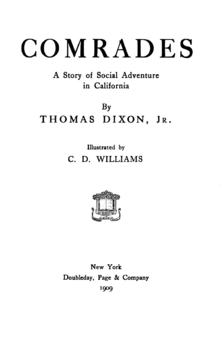 Title page of the first edition of Comrades. | |
| Authors | Thomas Dixon, Jr. |
|---|---|
| Language | English |
| Publisher | Doubleday, Page & Company [1] |
Publication date | 1909 [1] |
| Pages | 319 [1] |
Comrades: A Story of Social Adventure in California is a 1909 novel by Thomas Dixon, Jr. It deals with the establishment of a socialist commune on a Californian island and its subsequent unraveling. Widely reviewed, it was later adapted as a play and as a film.
Plot summary
Colonel Worth, a Confederate veteran, lives in San Francisco, California with his guardian Elena and his son Norman. [2] At the outset of the novel, Col. Worth talks about the Battle of Manila of the Spanish–American War in the Philippines, especially Admiral George Dewey's damage done to the Spanish fleet. [2] Meanwhile, his guardian and son go to a socialist meeting. [2] Indeed, his son Norman becomes infatuated with Barbara Bozenta, a socialist figure, and hosts a socialist meeting at Col. Worth's country house near Berkeley on July 4, American Independence Day. [2] The meeting is canceled when Norman attempts to put up the Red Flag as opposed to the American flag. [2]
Worth buys the island of Ventura for his son Norman. [2] Located off the coast of Santa Barbara, it is meant for Norman to establish a socialist commune there. [2] When his socialist friends fail to work, law and order needs to be restored. [2] However, Comrades Herman and Catherine Wolf take over as heads of the commune, and sentence Norman to work in the stables, under the threat of the lash. [2] Productivity falls as workers know they must work nine hours a day, and thus work slowly. [2] When Norman finds a way to find gold on the beach, the device is stolen by Wolf. [2] Wolf's wife Catherine then leaves for Santa Barbara, deeming family life to be too capitalistic. [2]
Eventually, Norman reaches out to his father and to the Governor of California, who liberate the island. [2] The Red flag is replaced with the American flag. [2]
Main themes
The book deals with the Bolshevik threat to the United States. [3] It has been described as 'a treatise against communism' by biographer Anthony Slide. [2]
Critical reception
A review published in The New York Times on February 6, 1909, suggested the characters were badly portrayed. [2] In April 1909, critic H.L. Mencken criticized the novel, describing it as 'intolerably amateurish' and a 'stupid quasi-novel.' [4] He added, 'towards the end the very badness of the book began to exercise a nefarious fascination.' [4] He concluded that the novel was a reflection of 'every weakness, fault, misdemeanor known to prose fiction, from incredible characterization to careless proofreading, and from preposterous dialogue to trashy illustrations.' [4]
Reviewer R. E. Bisbee in the July 1909 issue of Arena suggested the caricature of socialism made Dixon come across as an 'irrational teller of tales.' [2] More recently, biographer Anthony Slide criticized the novel, saying 'the writing appears as rushed as the novel's conclusions.' [2] He went on to add that the character were 'not sufficiently drawn out.' [2]
The novel has been compared to 1984 and Animal Farm by George Orwell in its ability to show the ineptitude of socialism. [2] However, Slide suggests it is a parody of the socialist novels of Upton Sinclair. [2] Moreover, it has been suggested that the character of Barbara Bozenta was based on anarchist Emma Goldman. [5]
Theatrical and cinematic adaptations
The novel was adapted as a play entitled The Red Dawn. [2] However, the characters have different names and the plot varies slightly. [2] Its first performance took place on August 6, 1919, at the 39th Street Theatre in New York City. [2]
Furthermore, the novel was adapted into a film in 1919. [3] It was entitled Bolshevism on Trial. [2] The film strayed from the plot of the novel, as it was set in Palm Beach, Florida as opposed to San Francisco. [2]
References
- ^ a b c HathiTrust: Comrades
- ^ a b c d e f g h i j k l m n o p q r s t u v w x y z Anthony Slide, American Racist: The Life and Films of Thomas Dixon, Louisville, Kentucky: University Press of Kentucky, 2004, pp. 127-141 [1]
- ^ a b Cary D. Wintz, 'Introduction', in Thomas Dixon, The Clansman: An Historical Romance of the Ku Klux Klan, M.E. Sharpe, 1941 , p. xv [2]
- ^ a b c H.L. Mencken, 'The Way to Happiness,' in H.L. Mencken's Smart Set Criticism, Regnery Gateway, 1987, p. 158 [3]
- ^ Laura Hapke, Labor's Text: The Worker in American Fiction, New Brunswick, New Jersey: Rutgers University Press, 2001, p. 150 [4]